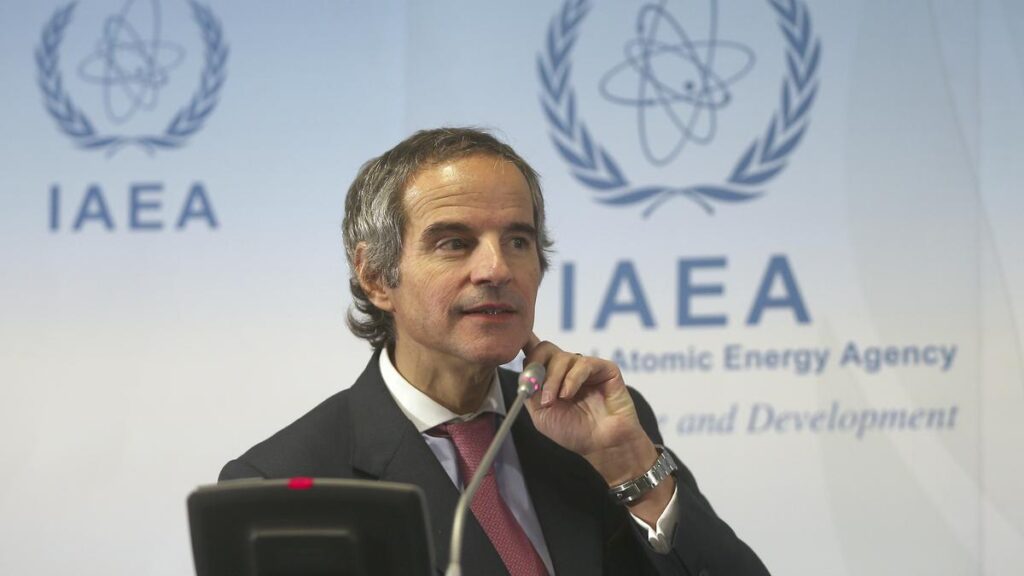
In this March 9, 2020, file photo, IAEA director-general Rafael Mariano Grossi from Argentina addresses the media after a meeting of the Board of Governors in Vienna, Austria.
| Photo Credit: Ronald Zak/AP
On June 12, 19 the Board of Governors of the International Atomic Energy Agency (IAEA) voted in favour of declaring “that Iran is in breach of its obligations under its 1974 Comprehensive Safeguards Agreement”.
Just a day later, Israel mounted what it called “preliminary strikes” against nuclear facilities in Iran and declared a state of emergency at home.
Three Board members — China, Russia, and Venezuela — voted against the resolution while 11 abstained. The Board represents 35 states in all.
The Board also expressed “grave concern” over Iran’s inability to explain traces of uranium found at the country’s Lavisan-Shian, Varamin, and Turquzabad sites.
Resolution welcomed
The IAEA is the U.N. nuclear watchdog tasked with promoting the use of nuclear energy for peaceful purposes and to discourage military applications, including in nuclear weapons.
This is the first time the Board has formally established non-compliance, which is required before it can escalate the matter with the U.N. Security Council. A previous resolution had only “urged” Iran’s cooperation.
Other Gulf states have welcomed the resolution. Israel, in addition to launching its strikes in the early hours of June 13, repeated its stance that it won’t “allow” Iran to enrich uranium to 90%, which is required to produce nuclear weapons.
Tehran reacted by denouncing the resolution as “political” and announcing plans for a new deep-underground enrichment complex, upgrades to centrifuges at its Fordow enrichment facility, and other “proportional measures”.
Following Israeli strikes, Tehran also said it had placed its air defence system on alert. Israeli military officials also claimed that Iran had mobilised a small fleet of drones.
Invoking Article XII.C
The Board of Governors approves safety standards, sets the IAEA’s budget, and appoints the director general with the approval of the body’s General Conference.
If and when IAEA inspectors report “non-compliance,” the Board can also call on the state to remedy the breach, curtail technical aid to the offending country, demand the return of supplied nuclear equipment or materials, and report the matter to all IAEA members.
These powers are specified under Article XII.C of its 1957 statute. Thus far, this Article has been invoked only six times: against Iraq (1991), Romania (1992), North Korea (1993), Iran (2006), Libya (2004), and Syria (2011).
At present the IAEA has around $1.5 million’s worth of projects in Iran, including in the form of radiopharmaceuticals, water desalination projects, and non-destructive nuclear tests.
Iran now has a “reasonable” amount of time within which to respond to the Board’s questions. If it doesn’t do so, the Board has the discretion to escalate its concerns up to the U.N. Security Council.
‘Not able to verify’
Under the 1974 Agreement, Iran is required to provide the IAEA with an inventory of nuclear materials and detailed data of any facility where nuclear material is present.
It also had to notify the IAEA before new facilities are built or modified, allow routine, ad hoc and special inspections, and maintain on-site devices that allow the IAEA to surveil the movement of nuclear material, especially for weapon use.
In its latest resolution, the Board also found, “consistent with Article 19 of Iran’s Comprehensive Safeguards Agreement, … that the Agency is not able to verify that there has been no diversion of nuclear material required to be safeguarded under the Agreement to nuclear weapons or other nuclear explosive devices.”
If the past is any indication, the Board is likely to vote on a follow-up report during another meeting in September 2025.
Once the Security Council receives the Board’s report, it may issue a presidential statement, adopt a resolution demanding compliance, or restore or expand sanctions against Iran.
Next steps
The timing of the Board’s resolution is notable: only four months before the U.N.’s relief from sanctions under the 2015 nuclear deal expires on October 18. After this date, the sanctions are expected to snap back.
The resolution also paralleled back-channel talks in Oman, which have been stalled.
The U.S. has already said it could support a “special inspection” of Iran’s nuclear facilities. IAEA director-general Rafael Mariano Grossi has also offered a “focused technical dialogue” with Iran while also cautioning that he would note Iran’s failure to comply in his August report to the Board.
Russia and China on the other hand have said the resolution “politicises” safeguards. They may also veto the Board’s Security Council referral later this year although they haven’t indicated as much.
Published – June 13, 2025 12:21 pm IST

